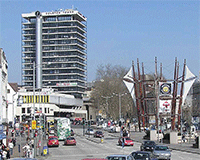There’s a lot of money looking for a home in Bristol. But will it find one?
At the moment the best guess is that funds and private-equity houses have lined up around £500m ready to buy in the laid-back capital of the South West.
Many of those potential buyers are destined to be disappointed. Bristol has only a handful of prime office buildings, and the same is true of the main out-of-town office park at Aztec West. For investors new to the city, this means tough competition for the best buildings. Gazumping is not unknown.
Competition for the best buildings helped Bristol office investment yields to dip below 6% for the first time earlier this year. The new low was set in March, when Invesco Real Estate sold the 75,000 sq ft Paragon building to Lothbury Property Trust for £29.5m, a net initial yield of 5.9%.
The deal pushed yields back from the 6.9% recorded four months earlier, when the Irish Banking Resolution Corporation sold the 162,000 sq ft Portwall Place building to BlackRock for £51.6m. It was a mighty lot-size for Bristol: £10-£20m is typical.
“No doubt yields would be driven down further if something came on the market,” says Andrew Main director of investment at Savills, who reckons 5.5% will become the new benchmark.
Will it come soon? Main isn’t so sure. “Supply remains low – owners hang on to what they’ve got – although higher prices might tempt more stock on to the market,” he says.
New speculative development by Salmon Harvester and NFU Mutual at 2 Glass Wharf (100,000 sq ft) and by Skanska at 66 Queen Square (61,000 sq ft) is a testament to constricted supply – and may provide new investment product.
Potential buyers such as Chris Taylor, chief executive at Hermes Real Estate, are keeping their eyes open. “Bristol is interesting to us,” he says. “It’s in a prosperous part of the UK, it has good transport, a good educational record, a wide industrial base and it’s very strong on financial services. We will look across the board.”
Local rumour suggests Hermes has gone further than just looking: deals are said to be in the air.
Like most regional UK cities, rental growth in the Bristol office market isn’t anything to write home about. Jeremy Richards, head of the Bristol office at JLL and president of the Bristol Property Agents Association, is realistic but hopeful. “The prospect of growth in the next five years is good, if we have the new offices to support it,” he says. “But the opportunity might be in good second-tier offices where, with refurbishment of the right properties, it’s possible to push rents up from £15 per sq ft to £20 per sq ft. That could be the real opportunity for growth.“
Rents could grow in the secondhand office market, too. Around 1m sq ft of office space has already been removed from the market for conversion into apartments – a further 500,000 sq ft was expected to go this year – squeezing the supply of good, secondhand office space.
“We probably have only 18 months’ supply of grade-B office space, so investors looking for triggers for rental growth should see that Bristol has a big ‘green for go’ flag flying over it,” says Darren Sheward, head of Lambert Smith Hampton in Bristol.
Sheward predicts incentives halving from four months’ rent-free per year of lease term, and top rents rising from £27.50 today to £30 per sq ft by 2016-17.
If there is a concern about Bristol it’s about the robustness of demand from office occupiers. Bristol has a broad-based economy – from digital media through to financial services. Take-up is improving but agents aren’t throwing their hats in the air. At least, not yet.
Research from Knight Frank suggests the improving trend. In the first half of 2014 some 300,000 sq ft of city office space was let, up 37% on the same period last year. It also reports 471,000 sq ft of active office requirements.
The same kinds of problems – good demand, low supply, sluggish rental growth – are conspicuous in the Avonmouth industrial market. “Not much gets traded,” he says. The latest bellwether deal – a 70,000 sq ft DSG Retail-occupied warehouse at Western Approach, sold to M&G Real Estate for £23m, a net initial yield of 7.13% – sets a healthy tone. Yields for secondhand sheds are typically around 8-9%, sales often ending in best bids.
Star turns and big cheeses
Bristol is a foodie city. It is surrounded by lush grassland, and rich cheeses and creams mingle with local delicacies such as Gloucester Old Spot pork to inspire some excellent chefs.
The city has two Michelin-starred restaurants – and two more are within striking distance in the immediate hinterland.
There’s a strong emphasis on locally sourced food – and a wide selection of local foodie outlets, especially in areas such as Clifton and Westbury upon Trim, and hipster destinations such as Stokes Croft.
Mr Mayor
George Ferguson, a leading figure in the world of UK architecture, has been Bristol’s first directly elected executive mayor since 2012. A former Liberal Democrat, he stood as an independent candidate.
Armed with his mandate, he has been shaking up council regeneration policy. Resolving the council’s own long-standing 230,000 sq ft office requirement and pushing on with plans for a 10,000-seat arena are among his achievements.











